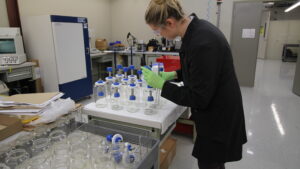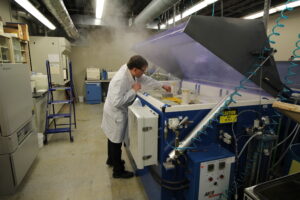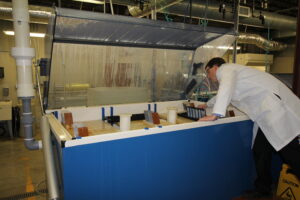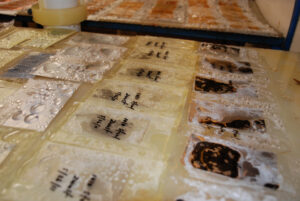While the NACE Standard TM0208 Vapor Inhibition Ability (VIA) test, also known as the VCI jar test, is a powerful tool for rapid analysis of VCI packaging and chemistry, it isn’t always robust enough to evaluate the complete protection of VCI packaging. In addition, it is even more limited in its capabilities for testing things like sprayable greases, rust preventative oil, and other directly applied rust preventatives. So, for testing volatile corrosion inhibitors and directly applied corrosion solutions, we turn to our array of environmental testing chambers. ZERUST® has 3 main flavors of environmental chambers for testing rust-inhibiting coatings and packaging, high humidity, salt fog, and cycling temperature and humidity chambers.

Our environmental testing chambers allow us to do longer-term and more in-depth and comparative studies on our products. In addition, because of the flexibility in how rust preventatives can be applied and the freedom to choose other metals to apply them to, we can test everything from Standard 1010 steel to aerospace-grade metals in combinations with our products to find the best corrosion protection solutions for the customer. Finally, this flexibility allows us to simulate the customer’s unique packaging system better. For example, a part can be treated in a specific machining fluid or fluids, in use by the customer, then packaged in various VCI packages, and then placed in the appropriate chamber to test the efficacy of the packaging solution.

This testing method does have its drawback. Namely, it is time-consuming. The tests take hundreds of hours in a chamber, and because the tested systems are more complex, the test matrix tends to be much larger, meaning setting up the test is more complicated and time-consuming. However, the test results from this testing are invaluable in that they approximate real-world testing in an accelerated fashion that cannot be accomplished in more rapid test scenarios. It also tests the system more thoroughly, considering the barrier properties of polymer products and coatings, which VCI testing does not accomplish.
For example, a test we regularly run in our humidity chambers is a “Salt Spritz” test. For this test, samples are sprayed with a methanol solution containing a known amount of sodium chloride (table salt). This allows us to put a controlled amount of corrosive material on the panels and tests our product’s ability to remove or neutralize the salt introduced into the system. This test is one of the most rapid tests we can do in our humidity chambers, usually taking only 3 or 4 days from sample preparation to test completion. However, this test relies on the product being tested to handle chloride contamination, which not all corrosion inhibiting products have.

We often turn to our cycling environment chambers for samples that are not intended to have a neutralizing effect. These tests cycle between a higher humidity, lower temperature state, and relatively lower humidity, high-temperature state, by the IEC 6068 standard. Cycling between high temperature, high humidity, and low-temperature low humidity is best for replicating shipping conditions in which the packaging won’t be exposed to an outdoor environment but may experience natural cycling of a day nigh temperature swing. We use this test in combination with salt spritz testing to confirm longer-term protection and an ability to neutralize salt contamination.
In almost all cases, this testing is conducted comparatively, with controls, both plain polyethylene film and known high-performing films and competitor films. This sort of Horse race style testing gives us the best idea of where products line up within our product ecosystem and the greater corrosion protection ecosystem. One thing this testing cannot do is predict real-world performance. We often record hours to corrosion; however, this hour count is not valid for real-world protection prediction.

The difficulty is in that our chambers are very well-controlled systems. They use deionized water, and the temperature is very well maintained. They also tend to approximate a worst-case scenario. There are few real-world situations where the packaging will be exposed to as much humidity as in our chambers. Similarly, we use pure sodium chloride when we purposely contaminate our panels with chloride. It is unlikely that any real-world situation would have such “clean” contamination.
When the limitations of chamber testing are weighed against the advantages, it is impossible to ignore the necessity of environmental chamber testing. The data collected from our various chambers is invaluable to our research and design process and our technical service team. In addition, chamber testing capability allows us to bring our customers top-of-the-line products and services.
